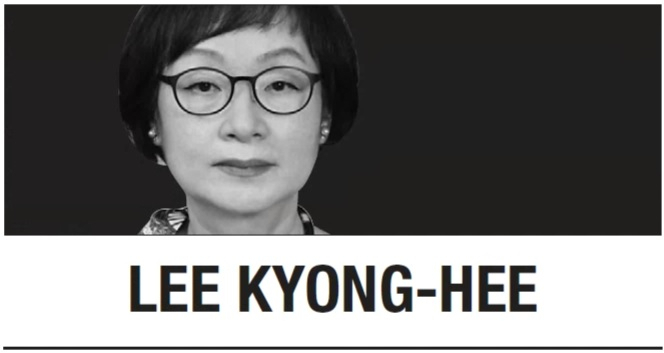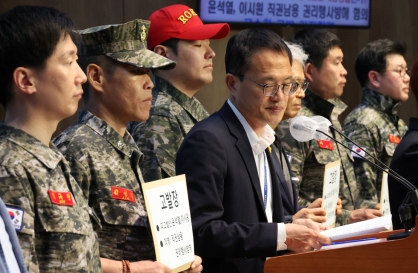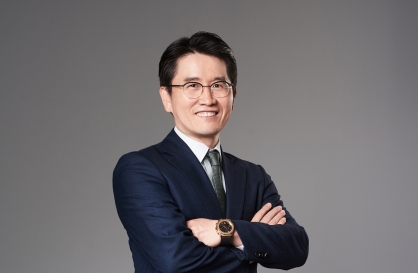[Lee Kyong-hee] Ideological divide over disputed war hero
By Korea HeraldPublished : Aug. 3, 2023 - 05:31

During my first visit to the Dabudong War Memorial Museum, footsteps could be easily heard. Only a handful of visitors paced through the small hillside museum that recalls pivotal, last-ditch fighting in the early stage of the Korean War.
The museum’s secluded site off the Seoul-Busan highway and a simple display of old howitzers and bazookas and memorial steles to fallen soldiers created a solemn atmosphere. They silently memorialized the unsung heroes who turned the tide of the war by protecting the last portion of the Korean Peninsula not seized by North Korean troops.
Today, the museum is no longer a treasured sanctuary of history aficionados. It echoes with the bustle of group tourists, mostly of the older generation. And the museum’s character is reshaped by three statues. Standing more than 4 meters in glittering gold, they seem disproportionate to their understated surroundings.
A new statue of Paik Sun-yup, the legendary commander of the critical Dabudong (or Tabu-dong) front line, overlooks the museum compound. It supposedly can be spun a full circle every two minutes, symbolizing the commander’s sweeping view of the battlefield.
Facing the statue of Paik, Korea’s first four-star general and an icon of Korea-US military ties, are statues of Syngman Rhee, the first president of the Republic of Korea, and Harry S. Truman, the 33rd president of the United States. They were unveiled a week ago, at the 70th anniversary of the Korean War armistice agreement.
The Rhee statue has him holding the Constitution of the Republic of Korea and Truman’s statue grasps the UN Charter. Together, they are intended to represent their wartime cooperation in defending the newborn Republic of Korea against communist aggression with support from the United Nations.
The backstory of how the outsized statues ended up in a tiny compound in a rather remote place is a reminder that the psychological wounds of the war are still raw and a palpable sign of the rise of the so-called conservative voices in our society.
The statues purportedly were made in 2017 through a private initiative. They were originally not intended to be together. Rhee’s statue was headed for the War Memorial of Korea in Seoul, but political conflict aborted the placement plan. Conservatives regard Rhee as a nation-builder, but progressives view him as an authoritarian responsible for the deaths and imprisonment of tens of thousands of people. Rhee died in exile in Hawaii in 1965 and his “return” in any form is divisive.
Eventually, North Gyeongsang Province, a conservative hotbed where Dabudong is located, volunteered to accept the statue. Conservatives also wanted to honor Truman for entering the war.
Although the Paik statue is logically placed at the site of battles he led, he too is a polarizing figure in the ongoing debate over the legacy of wartime leaders.
Park Min-shik, minister of patriots and veterans’ affairs, reignited controversy over Paik’s activity during the Japanese rule of Korea by removing the state burial record identifying him as a pro-Japanese figure. He said the description had no legal basis and Paik’s family petitioned for its removal, considering it defamation to the deceased.
The controversy stems from Paik’s service in the army of Manchukuo, a puppet state established by Imperial Japan in Manchuria, which he voluntarily joined in 1941. From 1943 to 1945, after graduating from a military academy in Fengtian, he served in the Gando Special Force, which mostly consisted of ethnic Koreans and is known for its brutality in suppressing Korean independence fighters.
Paik was a second lieutenant of the Manchukuo Imperial Army in 1945 when Japan surrendered in World War II ending its colonial occupation of Korea. The liberated Korea was divided into the US-occupied South and the Soviet-held North. Aware of Paik’s experiences with the Japanese military, the United States recruited him to help bolster the South’s military.
Paik never expressed regrets or apologized for his service in the Japanese army. In his autobiography published in Japan in 1993, he wrote, “We were trapped in Japan’s scheme to make ethnic Koreans suppress Korean independence fighters. Korea’s independence was not delayed due to our activity and even if we betrayed and became guerillas, independence would not have been advanced. But for aiming guns at our compatriots, we cannot avoid criticism.”
When Paik died in 2020, controversy raged over his funeral arrangements. The so-called liberals and the then ruling Democratic Party opposed his interment at any national cemetery while conservatives lionized him as a national savior and the father of the ROK military. In a compromise, he was laid to rest at the national cemetery in Daejeon, not in Seoul, but with the record that he was a “pro-Japanese and anti-nation” figure.
In 2009, Paik was among hundreds of Koreans who were placed on a list of such figures by a presidential committee for investigation of pro-Japanese collaborators during the colonial period.
The removal of the Paik listing has met with mixed reactions. Most notably, the Heritage of Korean Independence, a state-funded association of independence fighters and their descendants, called for the reinstatement of the record. In a statement, the association said it was worried that the Veteran Ministry’s arbitrary deletion without legal and procedural debates and public consensus might incite division among the people.
Seventy years since the armistice, no hope is in sight for formally ending the war, let alone the prospect of reunification of the divided peninsula. Worse still, dialogue between the two Koreas has completely halted amid escalating military tensions in the region. The prolonged territorial division has aggravated ideological divide among South Koreans. The hurried assemblage of the statues of historically refutable men on a less-than-ideal site obviously is yet another evidence of an unfinished conflict.
Lee Kyong-hee
Lee Kyong-hee is a former editor-in-chief of The Korea Herald. -- Ed.
-
Articles by Korea Herald






![[Weekender] How DDP emerged as an icon of Seoul](http://res.heraldm.com/phpwas/restmb_idxmake.php?idx=644&simg=/content/image/2024/04/25/20240425050915_0.jpg&u=)
![[Herald Interview] Guggenheim Museum makes a push for technology-based art with LG](http://res.heraldm.com/phpwas/restmb_idxmake.php?idx=644&simg=/content/image/2024/04/26/20240426050608_0.jpg&u=20240428114717)




![[Music in drama] An ode to childhood trauma](http://res.heraldm.com/phpwas/restmb_idxmake.php?idx=644&simg=/content/image/2024/04/25/20240425050929_0.jpg&u=)






![[Herald Interview] Mistakes turn into blessings in street performance, director says](http://res.heraldm.com/phpwas/restmb_idxmake.php?idx=652&simg=/content/image/2024/04/28/20240428050150_0.jpg&u=20240428174656)
